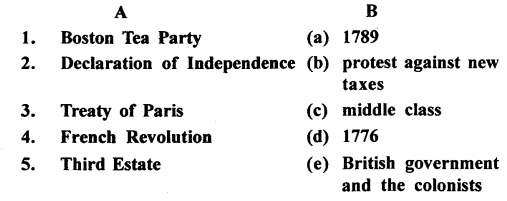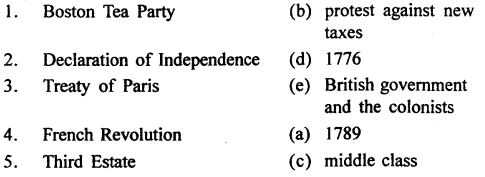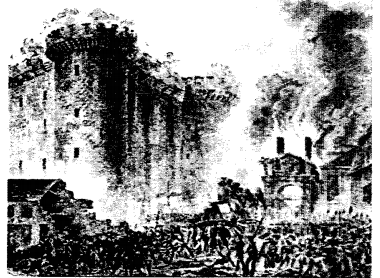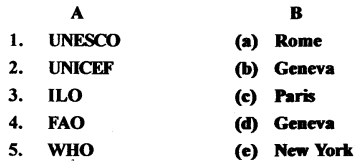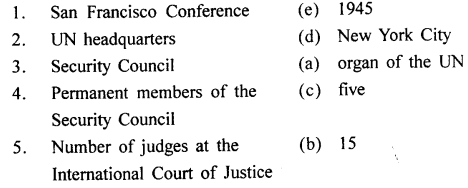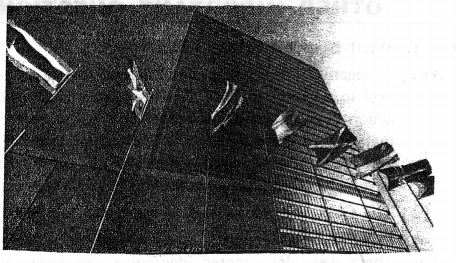The Trail History and Civics for Class 8 ICSE Solutions – The Beginning of the Modern World
ICSE SolutionsSelina ICSE SolutionsML Aggarwal Solutions
The Trail History and Civics for Class 8 ICSE Answers
Trail HistoryCivics Focus on HistoryCivics GeographyBiologyChemistryPhysicsMaths
A. Fill in the blanks:
- The Modern Age in India began with the conquest of India by the British.
- India was ruled by the British for nearly 200 years.
- The two kinds of source material for the Modem period are primary sources and secondary sources.
- The Renaissance ushered in revolutionary changes in Europe and marked the transition from the Medieval Age to the Modern Age.
- The four characteristic features of the Renaissance period are advent of new and powerful ideas of Humanism, rationalism, scientific spirit and spirit of inquiry.
B. Match the Following:


Answer:
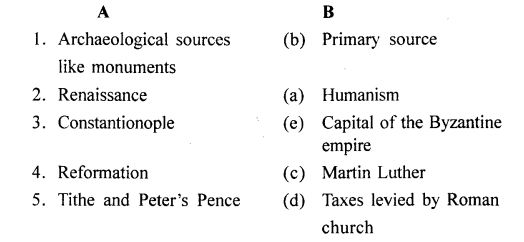
C. Choose the correct answer:
1. In India the Modern Period is generally regarded as having begun in the mid-15th/mid-18th/mid-16th century.
Ans. In India the Modem Period is generally regarded as having begun in the mid-18th century.
2. The primary sources for the study of the Modern Period are preserved in archives/banks/ factories.
Ans. The primary sources for the study of the Modem Period are preserved in archives.
3. The wealthy merchants and the professional class consisting of doctors, lawyers, teachers etc., formed the upper class/ middle class/lower class.
Ans.The wealthy merchants and the professional class consisting of doctors, lawyers, teachers etc., formed the middle class.
4. The invention of the printing press/telegraph/telephone helped to spread the ideas of the Renaissance thinkers far and wide.
Ans. The invention of the printing press helped to spread the ideas of the Renaissance thinkers far and wide.
5.Martin Luther was an Italian/a German/a French Christian monk.
Ans. Martin Luther was a German Christian monk
D. State whether the following are true or false:
- The source material of the Modern period is of two kinds— primary and secondary.
True
- Primary sources of history includes books, reviews, reports and articles.
False. Secondary sources of history includes books, reviews, reports and articles. - Renaissance scholars shifted the focus from divine affairs to human affairs.
True.
- The voyages of discoveries led to a decline of trade and commerce.
False.
- The Reformation was also known as the Protestant Movement.
True
E. Answer the following questions in one or two words/ sentences
Question 1.
The history of most nations can be divided into a number of periods. Name them.
Answer:
History in most countries is classified into three periods—ancient, medieval and modem. Each period has some characteristics— political, economic, religious and social — that sets it apart from other period.
Question 2.
What distinguishes one historical period from another ?
Answer:
Historical periods differ from country to country depending on the stage of development of that region.
Question 3.
In what way is the classification of historical periods useful to us ?
Answer:
The classification of historical periods helps to bring a sense of order and continuity to the bewildering array of historical processes that have taken place over centuries of evolution.
Question 4.
When did the Modern Period begin in (a) Europe (b) India?
Answer:
Europe the Modem Age started in 15th century. In India the Modem Period is generally regarded as having begun in the mid- 18th century.
Question 5.
Mention any four characteristic features of the Modern Period?
Answer:
The characteristic features of the Modern Period are: urbanization, technological advancement, democratic institutions, fundamental civil liberties, rationalism and humanism and industrialization.
Question 6.
Mention any two (a) primary and (b) secondary source materials of the Modern Period.
Answer:
(a)
Many of these primary sources have been preserved in archives and museums.
They include:
- Original documents like British official records
- Literary works like accounts of European residents, visitors and Indian officials, novels, plays, short stories and poems by British and Indian authors of this period
- Historical works by contemporary historians
- Artistic works like paintings, sketches engravings and drawings
- Photographs, audio cassettes, films and videotapes of incidents and interviews of important personalities
- Newspapers in both English and in Indian languages
- Archaeological remains like monuments and artifacts
(b)
Oral history
- Secondary Sources include books, reviews, reports and articles written by historians and scholars who study and research primary source material, interpret evidence and arrive at conclusions.
Question 7.
Why is it important to study developments in Europe to understand the history of modern India ?
Answer:
Since the Modern Age in India began with the advent of the British rule, the roots of the transition from the Medieval Period must be traced to Europe. To understand the impact of British rule on Indian history, it is imperative to understand the changes that were taking place in Europe.
Question 8.
What is the meaning of Renaissance ?
Answer:
A great movement of change and discovery spread across Europe which radically altered the pattern of peoples lives and thinking. This movement, representing a new spirit in every field of life, is referred to as the Renaissance. It is a French word that means ‘rebirth’ or ‘revival’.
Question 9.
What is meant by Reformation ?
Answer:
Reformation was a protest movement against the evil and authoritarian practices of the Catholic Church with a view to reform the Catholic Church.
Question 10.
What do you understand by nation states ?
Answer:
Nation States refers to the rise of strong and independent countries, in 14th century Europe, that had a common territory, with a well-defined boundary, and whose people were bound by common ties of culture, history, language and territory. The people of these nation states were also lived united under one government/ruler.
F. Answer the following questions briefly:
1. The capture of Constantinople by the Ottoman Turks led to the beginnings of Renaissance in Europe. With reference to this statement answer the following questions:
Question 1(a).
How did it lead to the revival of classical Greek and Roman learning in Europe ?
Answer:
A large number of Greek scholars fled from Constantinople, (a great center of classical Greek and Roman learning) to Italy with rare manuscripts. These scholars were patronized and encouraged by the rulers, scholars and the rich Italian merchants of Rome, Florence, Milan and Venice. Libraries were set up and universities were established to promote classical and modem learning.
Question 1(b).
What effect did it have on the outlook and attitudes of the people of Europe ?
Answer:
The Renaissance, or the revival of classical Graeco-Roman learning, inspired and encouraged people to question and challenge long established ideas and institutions that had been imposed on them by the church and their kings. They refused to blindly accept the dictates of their milers and the Church. They demanded to know the truth based on logic and reason and rejected everything that did not satisfy the yardstick of reason. This new spirit of rationalism led to the rise of scientific temper and the spirit of inquiry. This scientific temper and the desire to inquire or seek the truth led to new and varied developments in the fields of art, architecture, sculpture, painting, literature, science and technology.
Question 1(c).
What effect did it have on trade ?
Answer:
The Renaissance fostered a spirit of exploration and discovery’ which led to a steady growth of trade and commerce. A new class of rich merchants emerged in society. These merchants accumulated enormous wealth and helped their rulers to build prosperous, strong and stable states. The king’s dependence on feudal lands gradually declined.
Question 2.
With reference to the causes of the Reformation, how did the following contribute to the movement:
(a) Renaissance
(b) Evil practices of the Roman catholic Church
(c) Rise of strong and powerful rulers
Answer:
(a)
The Renaissance had radically altered the pattern of thinking and outlook of the people. It had set in motion the advent of new and powerful ideas of humanism, rationalism, scientific spirit and the spirit of Inquiry. These revolutionary ideas unleashed unstoppable forces that completely charged the way people thought and behaved. It was like the awakening of a sleeping giant.
People had finally found truthful and rational answers to their questions and discovered the real truth about themselves and their environment. Everything based on blind faith was questioned. The teachings of the Church were rejected and its authority challenged.
Even, the invention of the printing press helped to spread the ideas of the Renaissance thinkers quickly and far and wide.
(b)
With the passage of time the clergy, with some exceptions, began to lead immoral lives of luxury, wealth and comfort. The monasteries owned nearly one-third of the landed property in Europe. Religious duties and services to mankind were largely ignored or forgotten.
The Roman Church levied various taxes such as ‘tithe’ and ‘Peter’s Pence’ on all European Christians under their control. High fees were charged for conducting religious services. Bribery and corruption became common. Church offices were sold, bringing many unworthy people into the Church.
The Church also started the practice of selling “indulgences’ to those who had committed sins. It was like a certificate of pardon by God for their sins and a ‘passport to heaven” without having to undergo any penance.
With the decline of feudalism in Europe ,strong rule’s emerged. They defied the authority of the Pope and refused to let him interfere in their administrative affairs. They resented the papa! taxes and the drain of their wealth to Rome m the form of papa! taxes.
(G Picture study):
This is a portrait of the German monk who opposed certain activities of the Catholic Church.

(a) Identify the person in the picture.
Ans. Marlin Luther.
(b) With which great religious movement is his name associated?
Ans. Reformation movement.
(c) Where was he born and in which country did he lead his movement ?
Ans. Martin Luther was a German Christian monk and preacher at the University town of Witten burg.
(d) Mention any four effects of the movement started by him
Ans.
- The church was split up permanently.
- Civil wars broke out in many countries between the Catholics and the Protestants.
- Religious intolerance, hatred and persecution of Protestants in Catholic countries and Catholics in Protestant countries became the order of the day, and led to many wars in Europe.
- Religious persecution of the Protestants in England was a major reason for their migration to and colonization of North America (New England). By the end of the 18th century the colonists would establish the United States of America.




